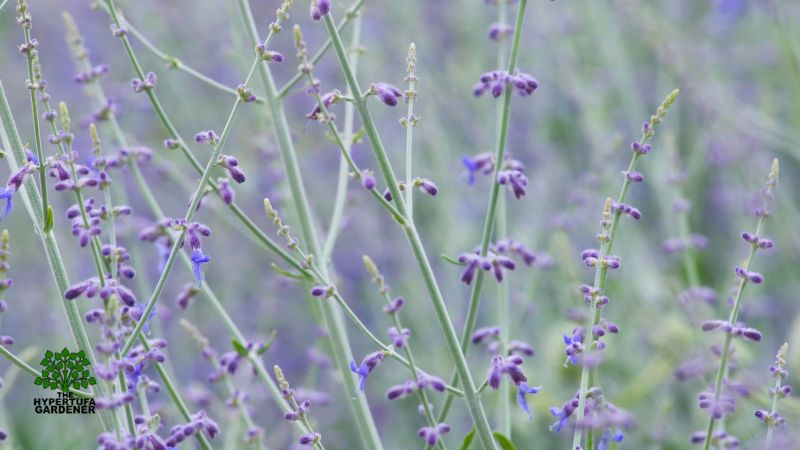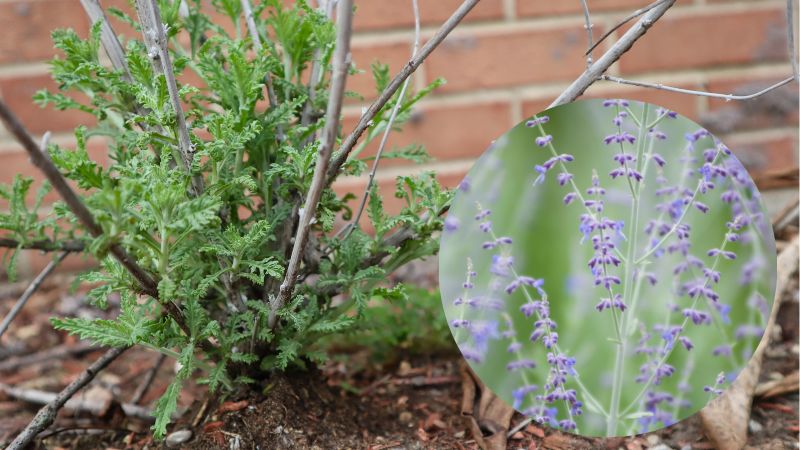Russian Sage For Easy Upkeep – Great Perennial!
Sunny and dry spot in your garden? For this sunny spot in my side garden, I chose Perennial Russian Sage (Perovskia atriplicifolia) and it has done very well over the past year.
I chose the Russian Sage because I knew it needed little care. There is a lot of it growing in old shopping centers and malls that have all but closed down and it is growing beautifully in clouds of purple throughout the summer.
So what could be better?

Want to grow a beautiful Russian Sage in your garden? Learn all the tips and tricks for care, propagation, pruning, and overwintering to keep your plant thriving all season long!
Russian Sage is a stunning perennial that adds color and texture to any garden. With its delicate purple flowers and fragrant leaves, this plant is a must-have for any gardener. But, contrary to a lot of plants, it requires little care and attention to keep it thriving.
Taking Care of Your Russian Sage: Tips for Optimal Growth
Russian Sage is a hardy plant (Zones 4-9) that’s easy to care for, but there are a few things you should keep in mind to keep it healthy and happy. Here are a few tips for taking care of your Russian Sage.

Plant in well-draining soil: Russian Sage likes well-draining soil that’s not too moist. Make sure to amend your soil with compost or sand to improve drainage if necessary.
Give it plenty of sun: This plant loves the sun, so make sure to plant it in a location that gets at least 6 hours of direct sunlight each day.
Water regularly in its first season. Russian Sage is heat and drought tolerant, but it can still use some watering during long dry spells. My plants are growing on the south side of my house and I basically ignore them all summer.
Fertilize regularly? Russian Sage doesn’t need fertilizing. In fact, too much water and nutrients may cause it to become floppy. Lots of sun and heat makes sturdy stems and lots of flowers.

Propagating Russian Sage: How to Grow More Plants from Cuttings
Take cuttings in the spring or summer: The best time to take cuttings is in the spring or summer when the plant is actively growing.
Choose healthy stems. Look for healthy stems that are about 6 inches long and have a few leaves.
Prepare the cuttings. Cut the stems just below a node (the point where a leaf attaches to the stem) and remove the lower leaves.
Root the cuttings. Dip the cuttings in rooting hormone and plant them in a well-draining potting mix. Keep the soil moist and place the pot in a bright, warm location.

Care for the cuttings. Water your cuttings regularly and keep the soil moist. In a few weeks, you should see new growth, and your cuttings will be well on their way to becoming new plants.
Pruning Russian Sage: How to Keep Your Plant Looking Its Best
Prune in the spring. Prune your Russian Sage in the spring, just before new growth begins.
Cut back the old growth which will be those dried out stems from last year. Cut back the old growth to about 6 inches from the ground. This will encourage new growth and more blooms.

Deadhead? I don’t feel that deadheading is needed with perennial Russian Sage. Perhaps snipping off a branch growing “wonky” is all that is needed. (And of course snipping some to propagate!)
Thin out the plant if you feel it’s needed. If your Russian Sage is getting too big and leggy, you can thin it out by cutting back some of the stems. This will help to keep your plant compact and bushy.
Long stems can be cut and displayed indoors. Dried arrangements are beautiful and smell wonderful. Despite its name, it is not a “sage” but a member of the mint family.
Overwintering Russian Sage: How to Keep Your Plant Alive Through the Winter
If you live in a colder climate, you’ll need to take a few extra steps to overwinter your Russian Sage. Here’s what you need to do.
Mulch lightly around the base of your Russian Sage to protect the roots from the cold. Use a layer of straw, leaves, or bark mulch.

When to cut back the stems? It is best to cut back the stems in spring as opposed to fall to about 6 inches from the ground. The branches left during the winter look great in snow here in Ohio. Once growth begins again in spring, cut older dead branches away.

Russian Sage is a beautiful and hardy plant that’s perfect for any garden. With its delicate purple flowers and fragrant leaves, it’s sure to be a showstopper in your yard. Whether you’re planting for the first time, propagating, pruning, or overwintering, I hope my tips and advice will help you keep your Russian Sage thriving all season long.
So why not give Russian Sage a try and add a little beauty to your garden this year?


